Asda Business: Interrelation of Functions, PESTEL and SWOT Analysis
VerifiedAdded on 2020/01/28
|11
|3343
|520
Report
AI Summary
This report provides a comprehensive analysis of Asda's business environment, focusing on the interrelation of organizational functions and their link to the company's objectives and structure. It examines the internal and external factors influencing Asda through SWOT and PESTEL analyses, respectively, highlighting the impact of political, economic, social, technological, environmental, and legal factors. The report explores how various functions, such as marketing, HR, finance, production, and IT, contribute to achieving Asda's goals, and how different organizational structures, including divisional, functional, and matrix structures, support these objectives. The PESTEL analysis delves into specific external factors, such as political regulations, economic conditions, social trends, technological advancements, environmental concerns, and legal frameworks affecting Asda's operations. Finally, the SWOT analysis evaluates Asda's internal strengths and weaknesses, and external opportunities and threats, providing a holistic view of its strategic position in the retail industry.
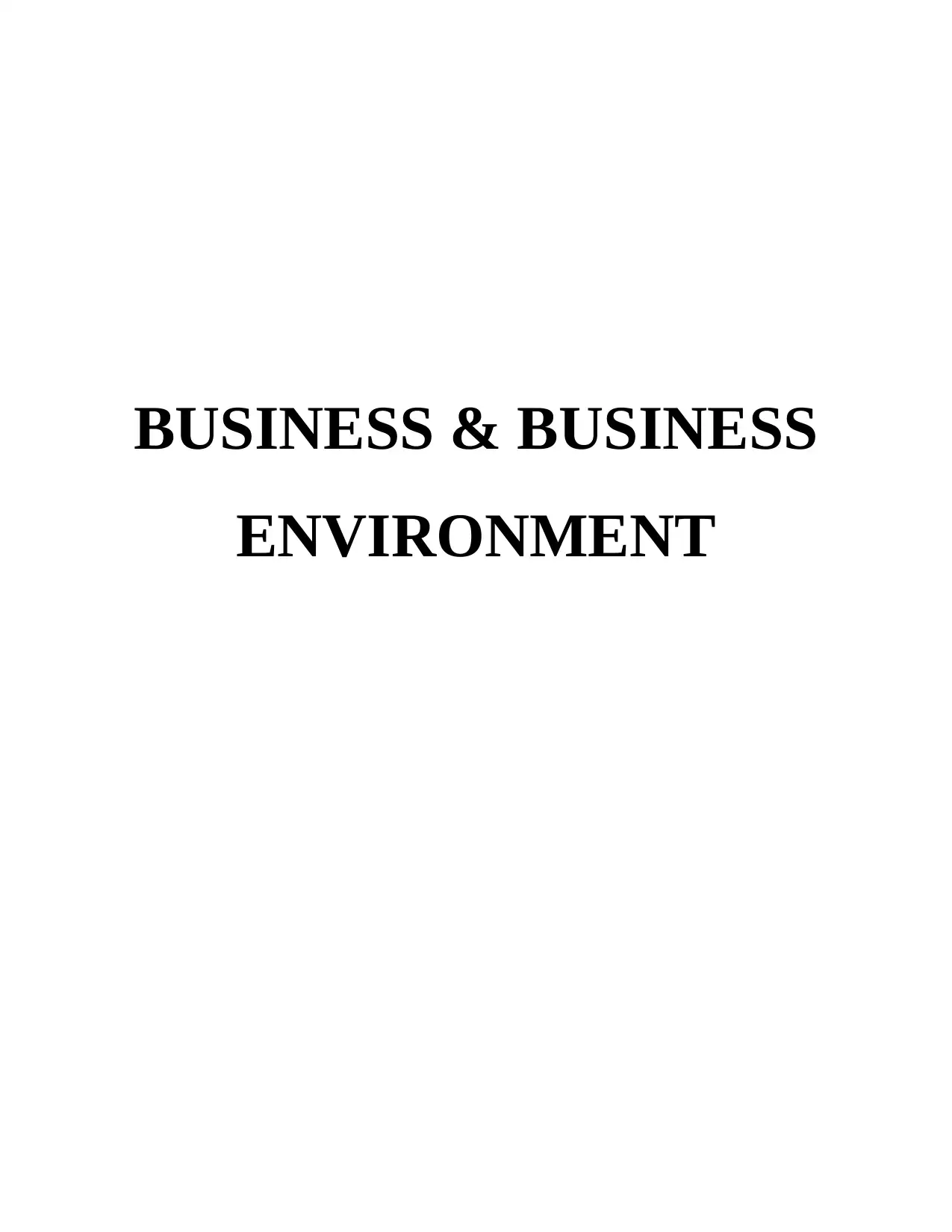
BUSINESS & BUSINESS
ENVIRONMENT
ENVIRONMENT
Paraphrase This Document
Need a fresh take? Get an instant paraphrase of this document with our AI Paraphraser
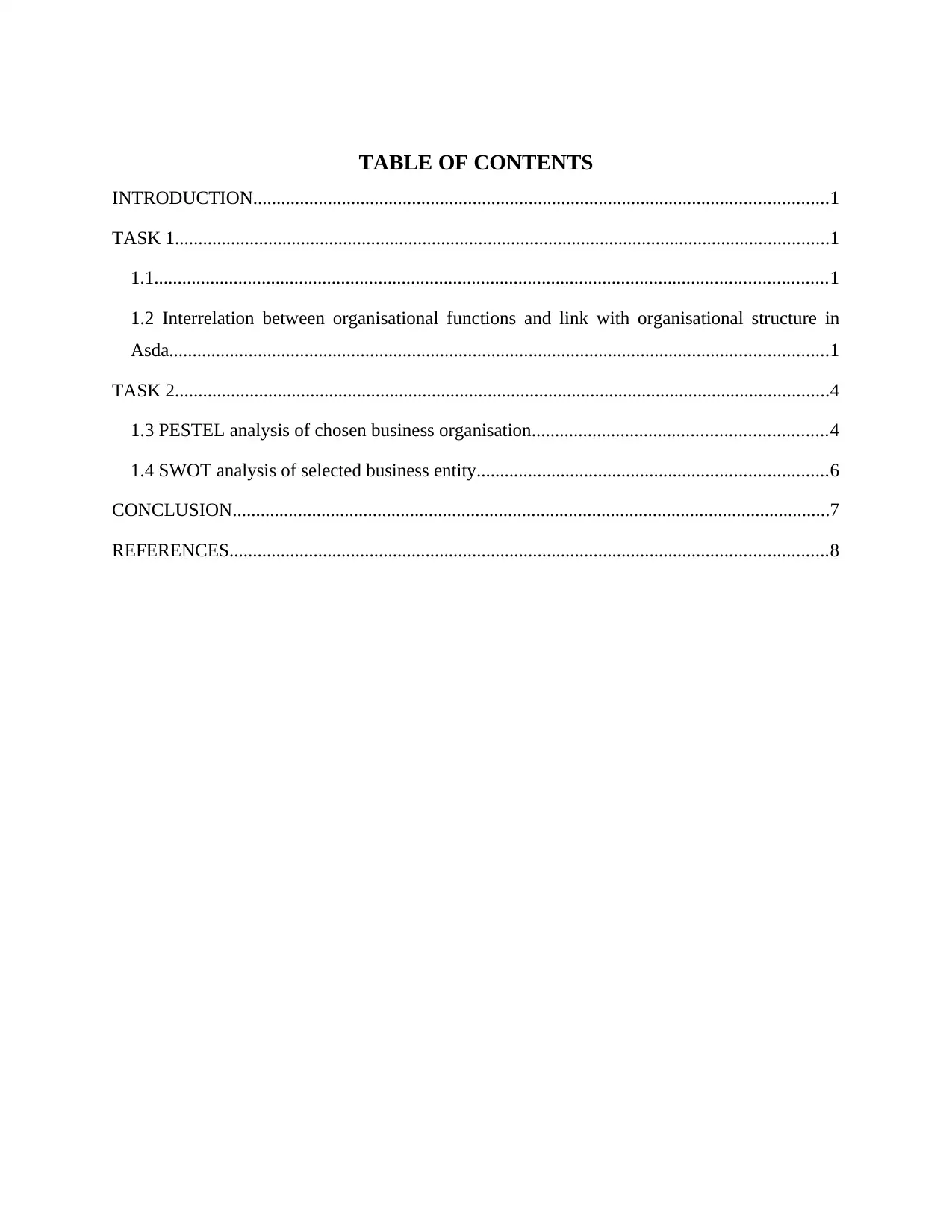
TABLE OF CONTENTS
INTRODUCTION...........................................................................................................................1
TASK 1............................................................................................................................................1
1.1................................................................................................................................................1
1.2 Interrelation between organisational functions and link with organisational structure in
Asda.............................................................................................................................................1
TASK 2............................................................................................................................................4
1.3 PESTEL analysis of chosen business organisation...............................................................4
1.4 SWOT analysis of selected business entity...........................................................................6
CONCLUSION................................................................................................................................7
REFERENCES................................................................................................................................8
INTRODUCTION...........................................................................................................................1
TASK 1............................................................................................................................................1
1.1................................................................................................................................................1
1.2 Interrelation between organisational functions and link with organisational structure in
Asda.............................................................................................................................................1
TASK 2............................................................................................................................................4
1.3 PESTEL analysis of chosen business organisation...............................................................4
1.4 SWOT analysis of selected business entity...........................................................................6
CONCLUSION................................................................................................................................7
REFERENCES................................................................................................................................8
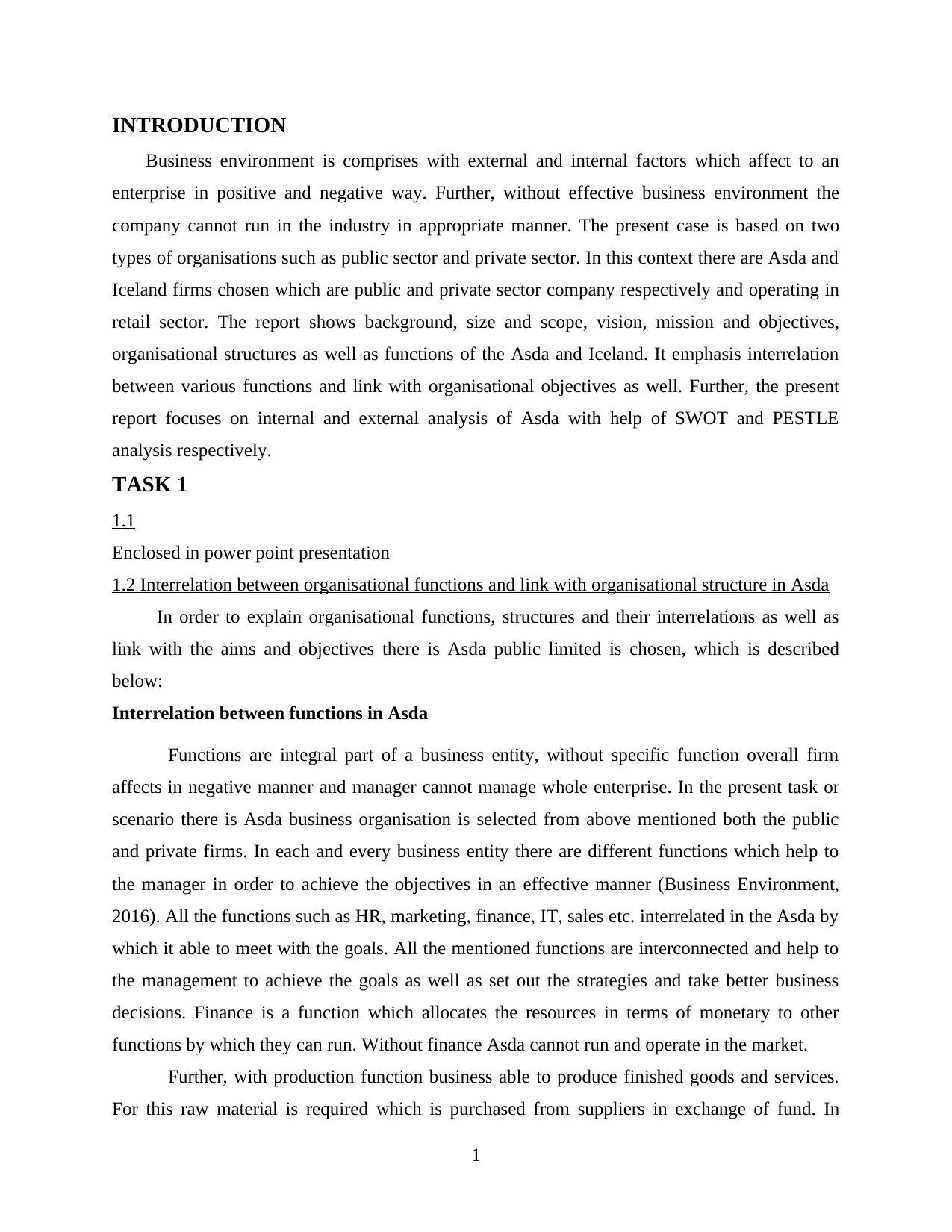
INTRODUCTION
Business environment is comprises with external and internal factors which affect to an
enterprise in positive and negative way. Further, without effective business environment the
company cannot run in the industry in appropriate manner. The present case is based on two
types of organisations such as public sector and private sector. In this context there are Asda and
Iceland firms chosen which are public and private sector company respectively and operating in
retail sector. The report shows background, size and scope, vision, mission and objectives,
organisational structures as well as functions of the Asda and Iceland. It emphasis interrelation
between various functions and link with organisational objectives as well. Further, the present
report focuses on internal and external analysis of Asda with help of SWOT and PESTLE
analysis respectively.
TASK 1
1.1
Enclosed in power point presentation
1.2 Interrelation between organisational functions and link with organisational structure in Asda
In order to explain organisational functions, structures and their interrelations as well as
link with the aims and objectives there is Asda public limited is chosen, which is described
below:
Interrelation between functions in Asda
Functions are integral part of a business entity, without specific function overall firm
affects in negative manner and manager cannot manage whole enterprise. In the present task or
scenario there is Asda business organisation is selected from above mentioned both the public
and private firms. In each and every business entity there are different functions which help to
the manager in order to achieve the objectives in an effective manner (Business Environment,
2016). All the functions such as HR, marketing, finance, IT, sales etc. interrelated in the Asda by
which it able to meet with the goals. All the mentioned functions are interconnected and help to
the management to achieve the goals as well as set out the strategies and take better business
decisions. Finance is a function which allocates the resources in terms of monetary to other
functions by which they can run. Without finance Asda cannot run and operate in the market.
Further, with production function business able to produce finished goods and services.
For this raw material is required which is purchased from suppliers in exchange of fund. In
1
Business environment is comprises with external and internal factors which affect to an
enterprise in positive and negative way. Further, without effective business environment the
company cannot run in the industry in appropriate manner. The present case is based on two
types of organisations such as public sector and private sector. In this context there are Asda and
Iceland firms chosen which are public and private sector company respectively and operating in
retail sector. The report shows background, size and scope, vision, mission and objectives,
organisational structures as well as functions of the Asda and Iceland. It emphasis interrelation
between various functions and link with organisational objectives as well. Further, the present
report focuses on internal and external analysis of Asda with help of SWOT and PESTLE
analysis respectively.
TASK 1
1.1
Enclosed in power point presentation
1.2 Interrelation between organisational functions and link with organisational structure in Asda
In order to explain organisational functions, structures and their interrelations as well as
link with the aims and objectives there is Asda public limited is chosen, which is described
below:
Interrelation between functions in Asda
Functions are integral part of a business entity, without specific function overall firm
affects in negative manner and manager cannot manage whole enterprise. In the present task or
scenario there is Asda business organisation is selected from above mentioned both the public
and private firms. In each and every business entity there are different functions which help to
the manager in order to achieve the objectives in an effective manner (Business Environment,
2016). All the functions such as HR, marketing, finance, IT, sales etc. interrelated in the Asda by
which it able to meet with the goals. All the mentioned functions are interconnected and help to
the management to achieve the goals as well as set out the strategies and take better business
decisions. Finance is a function which allocates the resources in terms of monetary to other
functions by which they can run. Without finance Asda cannot run and operate in the market.
Further, with production function business able to produce finished goods and services.
For this raw material is required which is purchased from suppliers in exchange of fund. In
1
⊘ This is a preview!⊘
Do you want full access?
Subscribe today to unlock all pages.

Trusted by 1+ million students worldwide
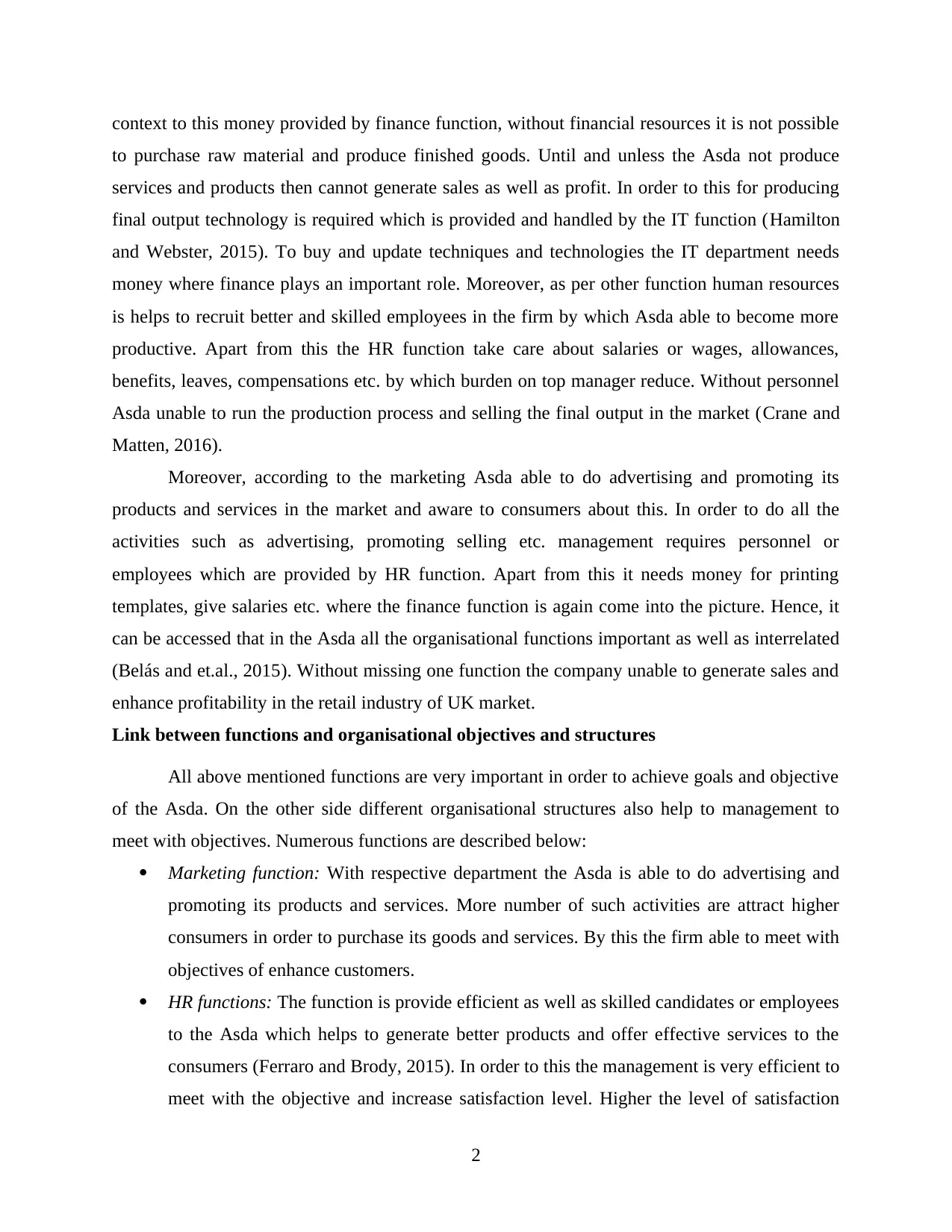
context to this money provided by finance function, without financial resources it is not possible
to purchase raw material and produce finished goods. Until and unless the Asda not produce
services and products then cannot generate sales as well as profit. In order to this for producing
final output technology is required which is provided and handled by the IT function (Hamilton
and Webster, 2015). To buy and update techniques and technologies the IT department needs
money where finance plays an important role. Moreover, as per other function human resources
is helps to recruit better and skilled employees in the firm by which Asda able to become more
productive. Apart from this the HR function take care about salaries or wages, allowances,
benefits, leaves, compensations etc. by which burden on top manager reduce. Without personnel
Asda unable to run the production process and selling the final output in the market (Crane and
Matten, 2016).
Moreover, according to the marketing Asda able to do advertising and promoting its
products and services in the market and aware to consumers about this. In order to do all the
activities such as advertising, promoting selling etc. management requires personnel or
employees which are provided by HR function. Apart from this it needs money for printing
templates, give salaries etc. where the finance function is again come into the picture. Hence, it
can be accessed that in the Asda all the organisational functions important as well as interrelated
(Belás and et.al., 2015). Without missing one function the company unable to generate sales and
enhance profitability in the retail industry of UK market.
Link between functions and organisational objectives and structures
All above mentioned functions are very important in order to achieve goals and objective
of the Asda. On the other side different organisational structures also help to management to
meet with objectives. Numerous functions are described below:
Marketing function: With respective department the Asda is able to do advertising and
promoting its products and services. More number of such activities are attract higher
consumers in order to purchase its goods and services. By this the firm able to meet with
objectives of enhance customers.
HR functions: The function is provide efficient as well as skilled candidates or employees
to the Asda which helps to generate better products and offer effective services to the
consumers (Ferraro and Brody, 2015). In order to this the management is very efficient to
meet with the objective and increase satisfaction level. Higher the level of satisfaction
2
to purchase raw material and produce finished goods. Until and unless the Asda not produce
services and products then cannot generate sales as well as profit. In order to this for producing
final output technology is required which is provided and handled by the IT function (Hamilton
and Webster, 2015). To buy and update techniques and technologies the IT department needs
money where finance plays an important role. Moreover, as per other function human resources
is helps to recruit better and skilled employees in the firm by which Asda able to become more
productive. Apart from this the HR function take care about salaries or wages, allowances,
benefits, leaves, compensations etc. by which burden on top manager reduce. Without personnel
Asda unable to run the production process and selling the final output in the market (Crane and
Matten, 2016).
Moreover, according to the marketing Asda able to do advertising and promoting its
products and services in the market and aware to consumers about this. In order to do all the
activities such as advertising, promoting selling etc. management requires personnel or
employees which are provided by HR function. Apart from this it needs money for printing
templates, give salaries etc. where the finance function is again come into the picture. Hence, it
can be accessed that in the Asda all the organisational functions important as well as interrelated
(Belás and et.al., 2015). Without missing one function the company unable to generate sales and
enhance profitability in the retail industry of UK market.
Link between functions and organisational objectives and structures
All above mentioned functions are very important in order to achieve goals and objective
of the Asda. On the other side different organisational structures also help to management to
meet with objectives. Numerous functions are described below:
Marketing function: With respective department the Asda is able to do advertising and
promoting its products and services. More number of such activities are attract higher
consumers in order to purchase its goods and services. By this the firm able to meet with
objectives of enhance customers.
HR functions: The function is provide efficient as well as skilled candidates or employees
to the Asda which helps to generate better products and offer effective services to the
consumers (Ferraro and Brody, 2015). In order to this the management is very efficient to
meet with the objective and increase satisfaction level. Higher the level of satisfaction
2
Paraphrase This Document
Need a fresh take? Get an instant paraphrase of this document with our AI Paraphraser
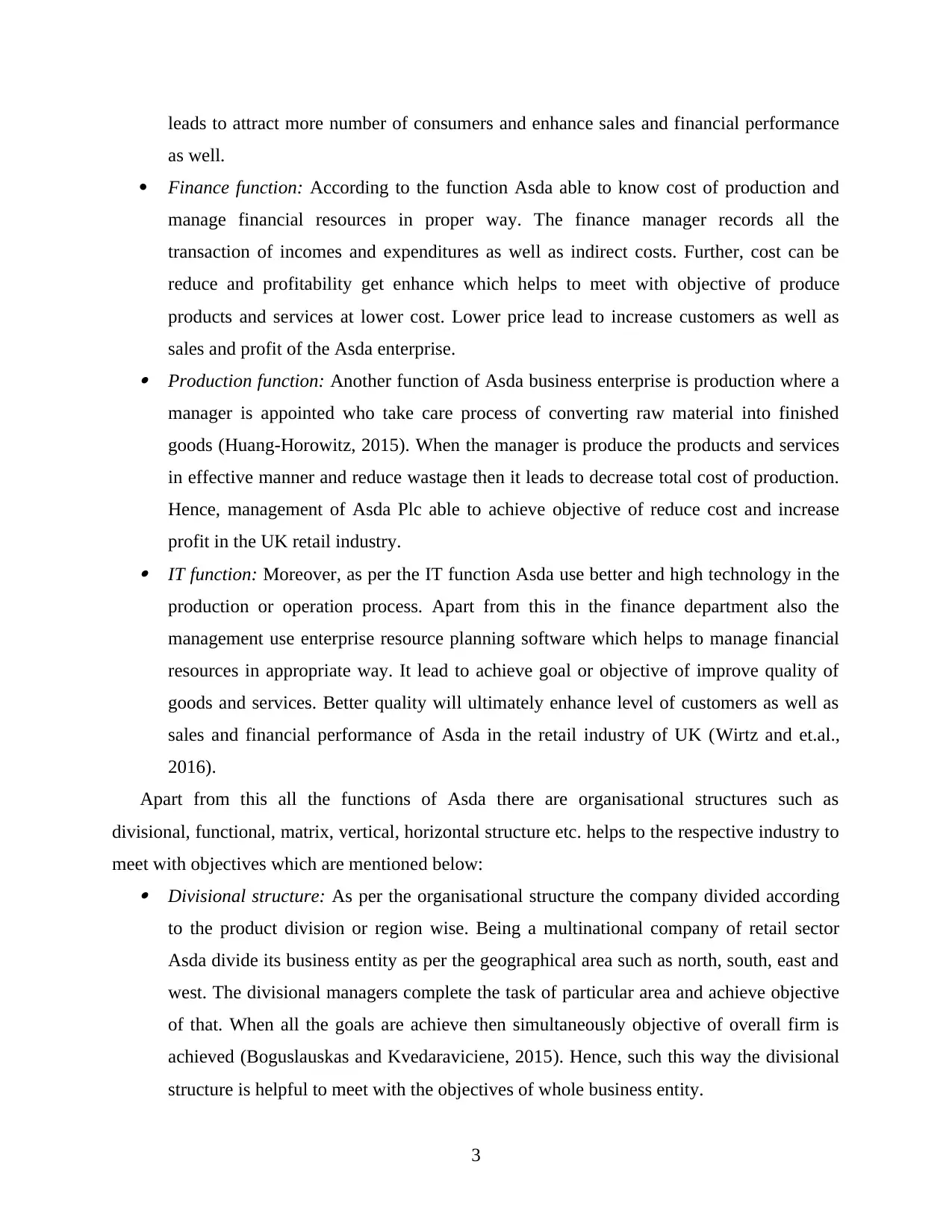
leads to attract more number of consumers and enhance sales and financial performance
as well.
Finance function: According to the function Asda able to know cost of production and
manage financial resources in proper way. The finance manager records all the
transaction of incomes and expenditures as well as indirect costs. Further, cost can be
reduce and profitability get enhance which helps to meet with objective of produce
products and services at lower cost. Lower price lead to increase customers as well as
sales and profit of the Asda enterprise. Production function: Another function of Asda business enterprise is production where a
manager is appointed who take care process of converting raw material into finished
goods (Huang-Horowitz, 2015). When the manager is produce the products and services
in effective manner and reduce wastage then it leads to decrease total cost of production.
Hence, management of Asda Plc able to achieve objective of reduce cost and increase
profit in the UK retail industry. IT function: Moreover, as per the IT function Asda use better and high technology in the
production or operation process. Apart from this in the finance department also the
management use enterprise resource planning software which helps to manage financial
resources in appropriate way. It lead to achieve goal or objective of improve quality of
goods and services. Better quality will ultimately enhance level of customers as well as
sales and financial performance of Asda in the retail industry of UK (Wirtz and et.al.,
2016).
Apart from this all the functions of Asda there are organisational structures such as
divisional, functional, matrix, vertical, horizontal structure etc. helps to the respective industry to
meet with objectives which are mentioned below: Divisional structure: As per the organisational structure the company divided according
to the product division or region wise. Being a multinational company of retail sector
Asda divide its business entity as per the geographical area such as north, south, east and
west. The divisional managers complete the task of particular area and achieve objective
of that. When all the goals are achieve then simultaneously objective of overall firm is
achieved (Boguslauskas and Kvedaraviciene, 2015). Hence, such this way the divisional
structure is helpful to meet with the objectives of whole business entity.
3
as well.
Finance function: According to the function Asda able to know cost of production and
manage financial resources in proper way. The finance manager records all the
transaction of incomes and expenditures as well as indirect costs. Further, cost can be
reduce and profitability get enhance which helps to meet with objective of produce
products and services at lower cost. Lower price lead to increase customers as well as
sales and profit of the Asda enterprise. Production function: Another function of Asda business enterprise is production where a
manager is appointed who take care process of converting raw material into finished
goods (Huang-Horowitz, 2015). When the manager is produce the products and services
in effective manner and reduce wastage then it leads to decrease total cost of production.
Hence, management of Asda Plc able to achieve objective of reduce cost and increase
profit in the UK retail industry. IT function: Moreover, as per the IT function Asda use better and high technology in the
production or operation process. Apart from this in the finance department also the
management use enterprise resource planning software which helps to manage financial
resources in appropriate way. It lead to achieve goal or objective of improve quality of
goods and services. Better quality will ultimately enhance level of customers as well as
sales and financial performance of Asda in the retail industry of UK (Wirtz and et.al.,
2016).
Apart from this all the functions of Asda there are organisational structures such as
divisional, functional, matrix, vertical, horizontal structure etc. helps to the respective industry to
meet with objectives which are mentioned below: Divisional structure: As per the organisational structure the company divided according
to the product division or region wise. Being a multinational company of retail sector
Asda divide its business entity as per the geographical area such as north, south, east and
west. The divisional managers complete the task of particular area and achieve objective
of that. When all the goals are achieve then simultaneously objective of overall firm is
achieved (Boguslauskas and Kvedaraviciene, 2015). Hence, such this way the divisional
structure is helpful to meet with the objectives of whole business entity.
3
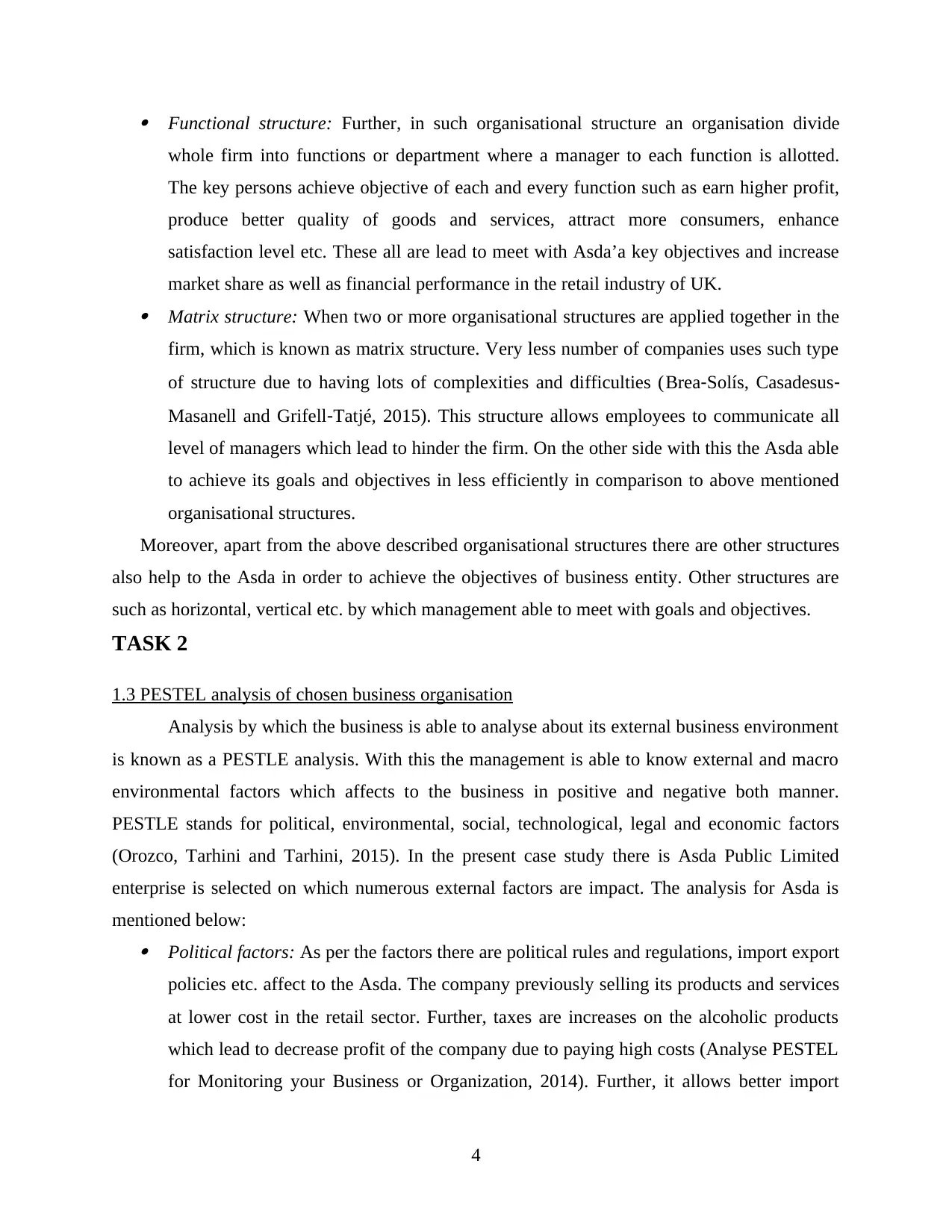
Functional structure: Further, in such organisational structure an organisation divide
whole firm into functions or department where a manager to each function is allotted.
The key persons achieve objective of each and every function such as earn higher profit,
produce better quality of goods and services, attract more consumers, enhance
satisfaction level etc. These all are lead to meet with Asda’a key objectives and increase
market share as well as financial performance in the retail industry of UK. Matrix structure: When two or more organisational structures are applied together in the
firm, which is known as matrix structure. Very less number of companies uses such type
of structure due to having lots of complexities and difficulties (Brea‐Solís, Casadesus‐
Masanell and Grifell‐Tatjé, 2015). This structure allows employees to communicate all
level of managers which lead to hinder the firm. On the other side with this the Asda able
to achieve its goals and objectives in less efficiently in comparison to above mentioned
organisational structures.
Moreover, apart from the above described organisational structures there are other structures
also help to the Asda in order to achieve the objectives of business entity. Other structures are
such as horizontal, vertical etc. by which management able to meet with goals and objectives.
TASK 2
1.3 PESTEL analysis of chosen business organisation
Analysis by which the business is able to analyse about its external business environment
is known as a PESTLE analysis. With this the management is able to know external and macro
environmental factors which affects to the business in positive and negative both manner.
PESTLE stands for political, environmental, social, technological, legal and economic factors
(Orozco, Tarhini and Tarhini, 2015). In the present case study there is Asda Public Limited
enterprise is selected on which numerous external factors are impact. The analysis for Asda is
mentioned below: Political factors: As per the factors there are political rules and regulations, import export
policies etc. affect to the Asda. The company previously selling its products and services
at lower cost in the retail sector. Further, taxes are increases on the alcoholic products
which lead to decrease profit of the company due to paying high costs (Analyse PESTEL
for Monitoring your Business or Organization, 2014). Further, it allows better import
4
whole firm into functions or department where a manager to each function is allotted.
The key persons achieve objective of each and every function such as earn higher profit,
produce better quality of goods and services, attract more consumers, enhance
satisfaction level etc. These all are lead to meet with Asda’a key objectives and increase
market share as well as financial performance in the retail industry of UK. Matrix structure: When two or more organisational structures are applied together in the
firm, which is known as matrix structure. Very less number of companies uses such type
of structure due to having lots of complexities and difficulties (Brea‐Solís, Casadesus‐
Masanell and Grifell‐Tatjé, 2015). This structure allows employees to communicate all
level of managers which lead to hinder the firm. On the other side with this the Asda able
to achieve its goals and objectives in less efficiently in comparison to above mentioned
organisational structures.
Moreover, apart from the above described organisational structures there are other structures
also help to the Asda in order to achieve the objectives of business entity. Other structures are
such as horizontal, vertical etc. by which management able to meet with goals and objectives.
TASK 2
1.3 PESTEL analysis of chosen business organisation
Analysis by which the business is able to analyse about its external business environment
is known as a PESTLE analysis. With this the management is able to know external and macro
environmental factors which affects to the business in positive and negative both manner.
PESTLE stands for political, environmental, social, technological, legal and economic factors
(Orozco, Tarhini and Tarhini, 2015). In the present case study there is Asda Public Limited
enterprise is selected on which numerous external factors are impact. The analysis for Asda is
mentioned below: Political factors: As per the factors there are political rules and regulations, import export
policies etc. affect to the Asda. The company previously selling its products and services
at lower cost in the retail sector. Further, taxes are increases on the alcoholic products
which lead to decrease profit of the company due to paying high costs (Analyse PESTEL
for Monitoring your Business or Organization, 2014). Further, it allows better import
4
⊘ This is a preview!⊘
Do you want full access?
Subscribe today to unlock all pages.

Trusted by 1+ million students worldwide
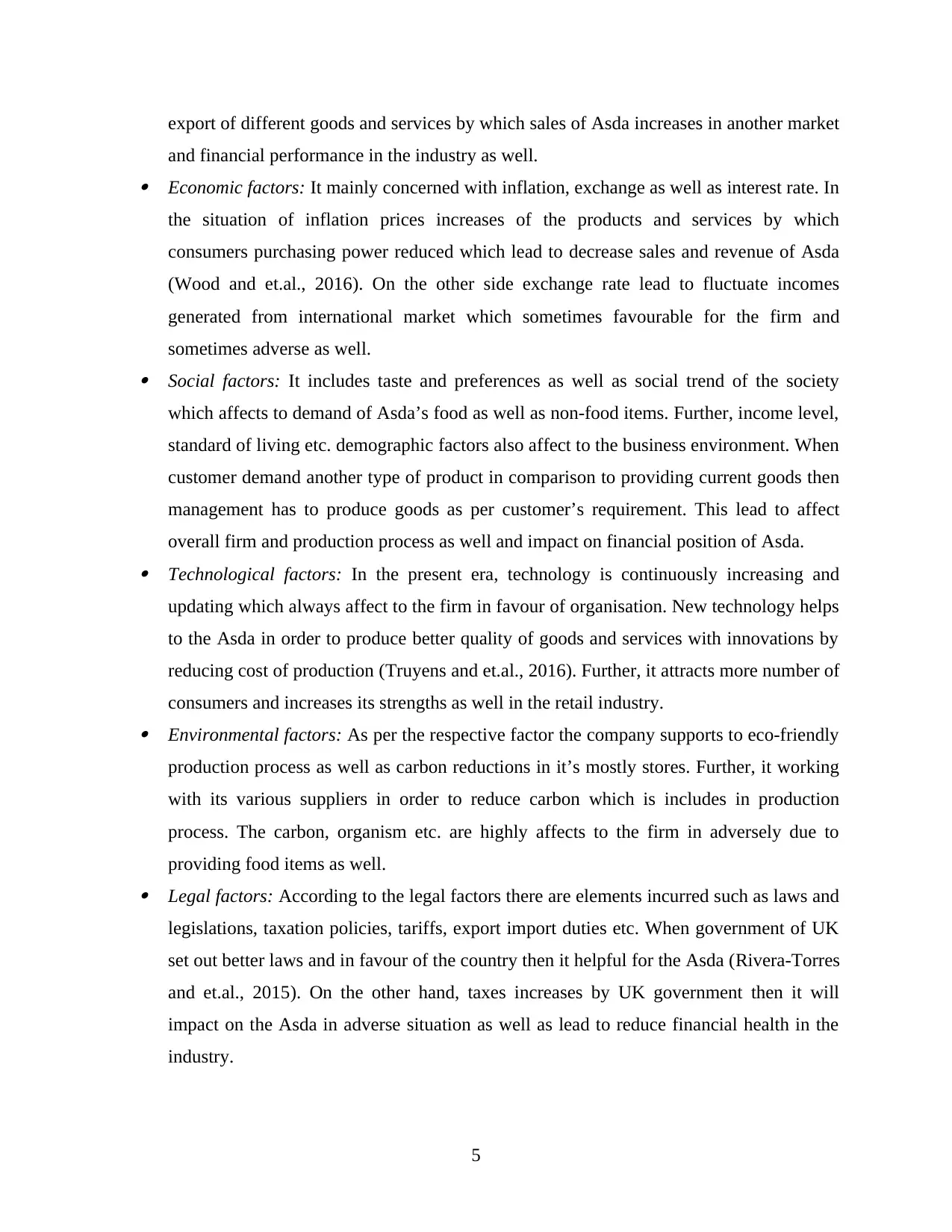
export of different goods and services by which sales of Asda increases in another market
and financial performance in the industry as well. Economic factors: It mainly concerned with inflation, exchange as well as interest rate. In
the situation of inflation prices increases of the products and services by which
consumers purchasing power reduced which lead to decrease sales and revenue of Asda
(Wood and et.al., 2016). On the other side exchange rate lead to fluctuate incomes
generated from international market which sometimes favourable for the firm and
sometimes adverse as well. Social factors: It includes taste and preferences as well as social trend of the society
which affects to demand of Asda’s food as well as non-food items. Further, income level,
standard of living etc. demographic factors also affect to the business environment. When
customer demand another type of product in comparison to providing current goods then
management has to produce goods as per customer’s requirement. This lead to affect
overall firm and production process as well and impact on financial position of Asda. Technological factors: In the present era, technology is continuously increasing and
updating which always affect to the firm in favour of organisation. New technology helps
to the Asda in order to produce better quality of goods and services with innovations by
reducing cost of production (Truyens and et.al., 2016). Further, it attracts more number of
consumers and increases its strengths as well in the retail industry. Environmental factors: As per the respective factor the company supports to eco-friendly
production process as well as carbon reductions in it’s mostly stores. Further, it working
with its various suppliers in order to reduce carbon which is includes in production
process. The carbon, organism etc. are highly affects to the firm in adversely due to
providing food items as well. Legal factors: According to the legal factors there are elements incurred such as laws and
legislations, taxation policies, tariffs, export import duties etc. When government of UK
set out better laws and in favour of the country then it helpful for the Asda (Rivera-Torres
and et.al., 2015). On the other hand, taxes increases by UK government then it will
impact on the Asda in adverse situation as well as lead to reduce financial health in the
industry.
5
and financial performance in the industry as well. Economic factors: It mainly concerned with inflation, exchange as well as interest rate. In
the situation of inflation prices increases of the products and services by which
consumers purchasing power reduced which lead to decrease sales and revenue of Asda
(Wood and et.al., 2016). On the other side exchange rate lead to fluctuate incomes
generated from international market which sometimes favourable for the firm and
sometimes adverse as well. Social factors: It includes taste and preferences as well as social trend of the society
which affects to demand of Asda’s food as well as non-food items. Further, income level,
standard of living etc. demographic factors also affect to the business environment. When
customer demand another type of product in comparison to providing current goods then
management has to produce goods as per customer’s requirement. This lead to affect
overall firm and production process as well and impact on financial position of Asda. Technological factors: In the present era, technology is continuously increasing and
updating which always affect to the firm in favour of organisation. New technology helps
to the Asda in order to produce better quality of goods and services with innovations by
reducing cost of production (Truyens and et.al., 2016). Further, it attracts more number of
consumers and increases its strengths as well in the retail industry. Environmental factors: As per the respective factor the company supports to eco-friendly
production process as well as carbon reductions in it’s mostly stores. Further, it working
with its various suppliers in order to reduce carbon which is includes in production
process. The carbon, organism etc. are highly affects to the firm in adversely due to
providing food items as well. Legal factors: According to the legal factors there are elements incurred such as laws and
legislations, taxation policies, tariffs, export import duties etc. When government of UK
set out better laws and in favour of the country then it helpful for the Asda (Rivera-Torres
and et.al., 2015). On the other hand, taxes increases by UK government then it will
impact on the Asda in adverse situation as well as lead to reduce financial health in the
industry.
5
Paraphrase This Document
Need a fresh take? Get an instant paraphrase of this document with our AI Paraphraser
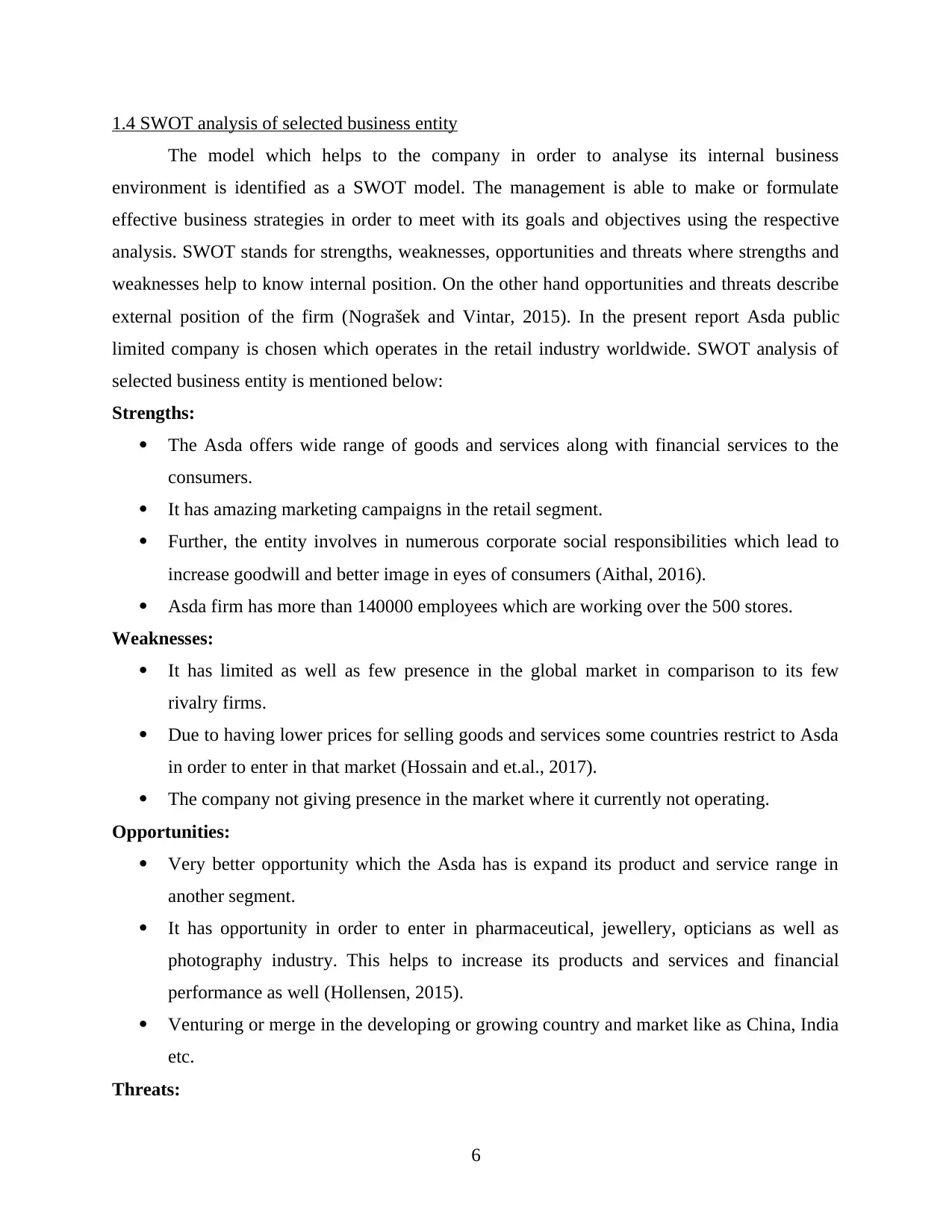
1.4 SWOT analysis of selected business entity
The model which helps to the company in order to analyse its internal business
environment is identified as a SWOT model. The management is able to make or formulate
effective business strategies in order to meet with its goals and objectives using the respective
analysis. SWOT stands for strengths, weaknesses, opportunities and threats where strengths and
weaknesses help to know internal position. On the other hand opportunities and threats describe
external position of the firm (Nograšek and Vintar, 2015). In the present report Asda public
limited company is chosen which operates in the retail industry worldwide. SWOT analysis of
selected business entity is mentioned below:
Strengths:
The Asda offers wide range of goods and services along with financial services to the
consumers.
It has amazing marketing campaigns in the retail segment.
Further, the entity involves in numerous corporate social responsibilities which lead to
increase goodwill and better image in eyes of consumers (Aithal, 2016).
Asda firm has more than 140000 employees which are working over the 500 stores.
Weaknesses:
It has limited as well as few presence in the global market in comparison to its few
rivalry firms.
Due to having lower prices for selling goods and services some countries restrict to Asda
in order to enter in that market (Hossain and et.al., 2017).
The company not giving presence in the market where it currently not operating.
Opportunities:
Very better opportunity which the Asda has is expand its product and service range in
another segment.
It has opportunity in order to enter in pharmaceutical, jewellery, opticians as well as
photography industry. This helps to increase its products and services and financial
performance as well (Hollensen, 2015).
Venturing or merge in the developing or growing country and market like as China, India
etc.
Threats:
6
The model which helps to the company in order to analyse its internal business
environment is identified as a SWOT model. The management is able to make or formulate
effective business strategies in order to meet with its goals and objectives using the respective
analysis. SWOT stands for strengths, weaknesses, opportunities and threats where strengths and
weaknesses help to know internal position. On the other hand opportunities and threats describe
external position of the firm (Nograšek and Vintar, 2015). In the present report Asda public
limited company is chosen which operates in the retail industry worldwide. SWOT analysis of
selected business entity is mentioned below:
Strengths:
The Asda offers wide range of goods and services along with financial services to the
consumers.
It has amazing marketing campaigns in the retail segment.
Further, the entity involves in numerous corporate social responsibilities which lead to
increase goodwill and better image in eyes of consumers (Aithal, 2016).
Asda firm has more than 140000 employees which are working over the 500 stores.
Weaknesses:
It has limited as well as few presence in the global market in comparison to its few
rivalry firms.
Due to having lower prices for selling goods and services some countries restrict to Asda
in order to enter in that market (Hossain and et.al., 2017).
The company not giving presence in the market where it currently not operating.
Opportunities:
Very better opportunity which the Asda has is expand its product and service range in
another segment.
It has opportunity in order to enter in pharmaceutical, jewellery, opticians as well as
photography industry. This helps to increase its products and services and financial
performance as well (Hollensen, 2015).
Venturing or merge in the developing or growing country and market like as China, India
etc.
Threats:
6
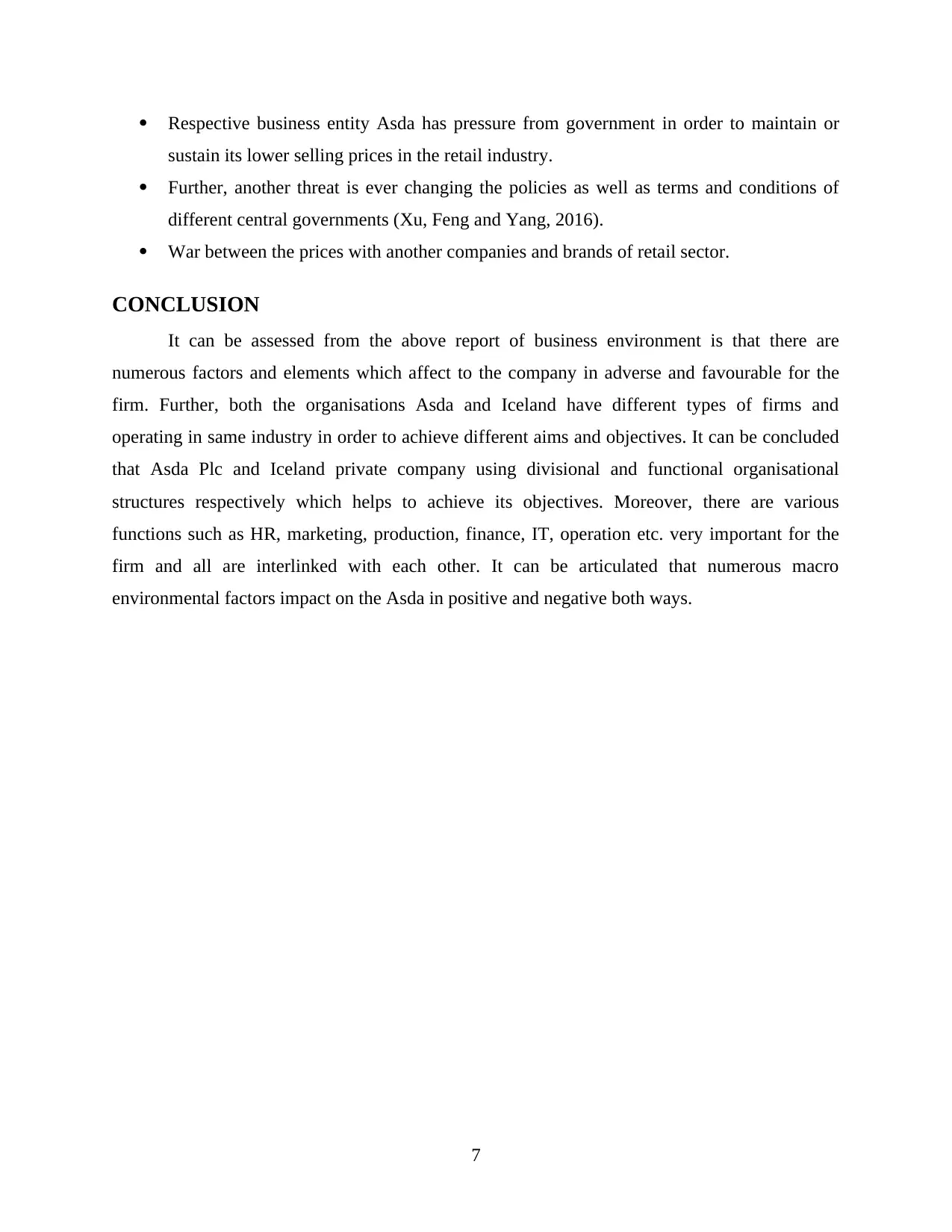
Respective business entity Asda has pressure from government in order to maintain or
sustain its lower selling prices in the retail industry.
Further, another threat is ever changing the policies as well as terms and conditions of
different central governments (Xu, Feng and Yang, 2016).
War between the prices with another companies and brands of retail sector.
CONCLUSION
It can be assessed from the above report of business environment is that there are
numerous factors and elements which affect to the company in adverse and favourable for the
firm. Further, both the organisations Asda and Iceland have different types of firms and
operating in same industry in order to achieve different aims and objectives. It can be concluded
that Asda Plc and Iceland private company using divisional and functional organisational
structures respectively which helps to achieve its objectives. Moreover, there are various
functions such as HR, marketing, production, finance, IT, operation etc. very important for the
firm and all are interlinked with each other. It can be articulated that numerous macro
environmental factors impact on the Asda in positive and negative both ways.
7
sustain its lower selling prices in the retail industry.
Further, another threat is ever changing the policies as well as terms and conditions of
different central governments (Xu, Feng and Yang, 2016).
War between the prices with another companies and brands of retail sector.
CONCLUSION
It can be assessed from the above report of business environment is that there are
numerous factors and elements which affect to the company in adverse and favourable for the
firm. Further, both the organisations Asda and Iceland have different types of firms and
operating in same industry in order to achieve different aims and objectives. It can be concluded
that Asda Plc and Iceland private company using divisional and functional organisational
structures respectively which helps to achieve its objectives. Moreover, there are various
functions such as HR, marketing, production, finance, IT, operation etc. very important for the
firm and all are interlinked with each other. It can be articulated that numerous macro
environmental factors impact on the Asda in positive and negative both ways.
7
⊘ This is a preview!⊘
Do you want full access?
Subscribe today to unlock all pages.

Trusted by 1+ million students worldwide
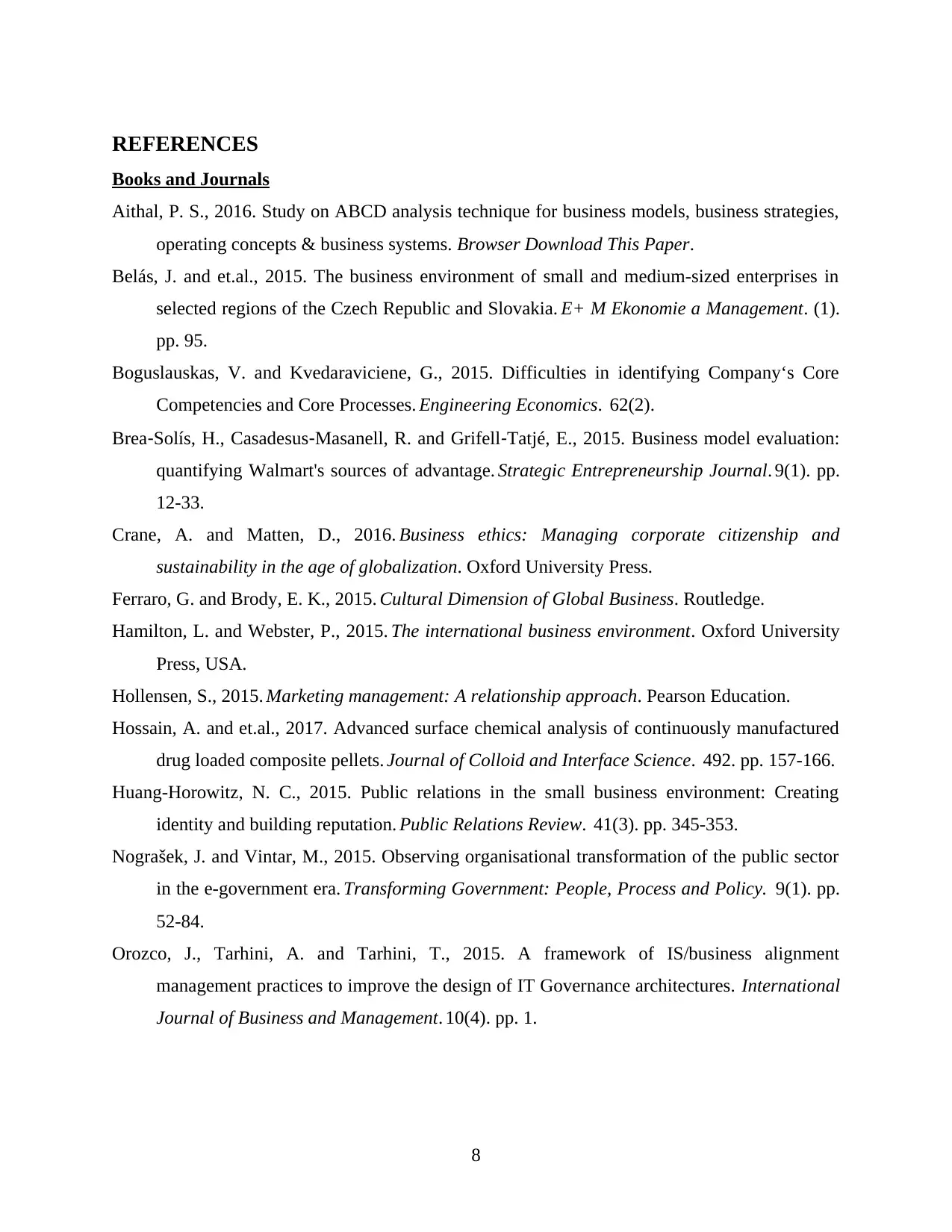
REFERENCES
Books and Journals
Aithal, P. S., 2016. Study on ABCD analysis technique for business models, business strategies,
operating concepts & business systems. Browser Download This Paper.
Belás, J. and et.al., 2015. The business environment of small and medium-sized enterprises in
selected regions of the Czech Republic and Slovakia. E+ M Ekonomie a Management. (1).
pp. 95.
Boguslauskas, V. and Kvedaraviciene, G., 2015. Difficulties in identifying Company‘s Core
Competencies and Core Processes. Engineering Economics. 62(2).
Brea‐Solís, H., Casadesus‐Masanell, R. and Grifell‐Tatjé, E., 2015. Business model evaluation:
quantifying Walmart's sources of advantage. Strategic Entrepreneurship Journal. 9(1). pp.
12-33.
Crane, A. and Matten, D., 2016. Business ethics: Managing corporate citizenship and
sustainability in the age of globalization. Oxford University Press.
Ferraro, G. and Brody, E. K., 2015. Cultural Dimension of Global Business. Routledge.
Hamilton, L. and Webster, P., 2015. The international business environment. Oxford University
Press, USA.
Hollensen, S., 2015. Marketing management: A relationship approach. Pearson Education.
Hossain, A. and et.al., 2017. Advanced surface chemical analysis of continuously manufactured
drug loaded composite pellets. Journal of Colloid and Interface Science. 492. pp. 157-166.
Huang-Horowitz, N. C., 2015. Public relations in the small business environment: Creating
identity and building reputation. Public Relations Review. 41(3). pp. 345-353.
Nograšek, J. and Vintar, M., 2015. Observing organisational transformation of the public sector
in the e-government era. Transforming Government: People, Process and Policy. 9(1). pp.
52-84.
Orozco, J., Tarhini, A. and Tarhini, T., 2015. A framework of IS/business alignment
management practices to improve the design of IT Governance architectures. International
Journal of Business and Management. 10(4). pp. 1.
8
Books and Journals
Aithal, P. S., 2016. Study on ABCD analysis technique for business models, business strategies,
operating concepts & business systems. Browser Download This Paper.
Belás, J. and et.al., 2015. The business environment of small and medium-sized enterprises in
selected regions of the Czech Republic and Slovakia. E+ M Ekonomie a Management. (1).
pp. 95.
Boguslauskas, V. and Kvedaraviciene, G., 2015. Difficulties in identifying Company‘s Core
Competencies and Core Processes. Engineering Economics. 62(2).
Brea‐Solís, H., Casadesus‐Masanell, R. and Grifell‐Tatjé, E., 2015. Business model evaluation:
quantifying Walmart's sources of advantage. Strategic Entrepreneurship Journal. 9(1). pp.
12-33.
Crane, A. and Matten, D., 2016. Business ethics: Managing corporate citizenship and
sustainability in the age of globalization. Oxford University Press.
Ferraro, G. and Brody, E. K., 2015. Cultural Dimension of Global Business. Routledge.
Hamilton, L. and Webster, P., 2015. The international business environment. Oxford University
Press, USA.
Hollensen, S., 2015. Marketing management: A relationship approach. Pearson Education.
Hossain, A. and et.al., 2017. Advanced surface chemical analysis of continuously manufactured
drug loaded composite pellets. Journal of Colloid and Interface Science. 492. pp. 157-166.
Huang-Horowitz, N. C., 2015. Public relations in the small business environment: Creating
identity and building reputation. Public Relations Review. 41(3). pp. 345-353.
Nograšek, J. and Vintar, M., 2015. Observing organisational transformation of the public sector
in the e-government era. Transforming Government: People, Process and Policy. 9(1). pp.
52-84.
Orozco, J., Tarhini, A. and Tarhini, T., 2015. A framework of IS/business alignment
management practices to improve the design of IT Governance architectures. International
Journal of Business and Management. 10(4). pp. 1.
8
Paraphrase This Document
Need a fresh take? Get an instant paraphrase of this document with our AI Paraphraser
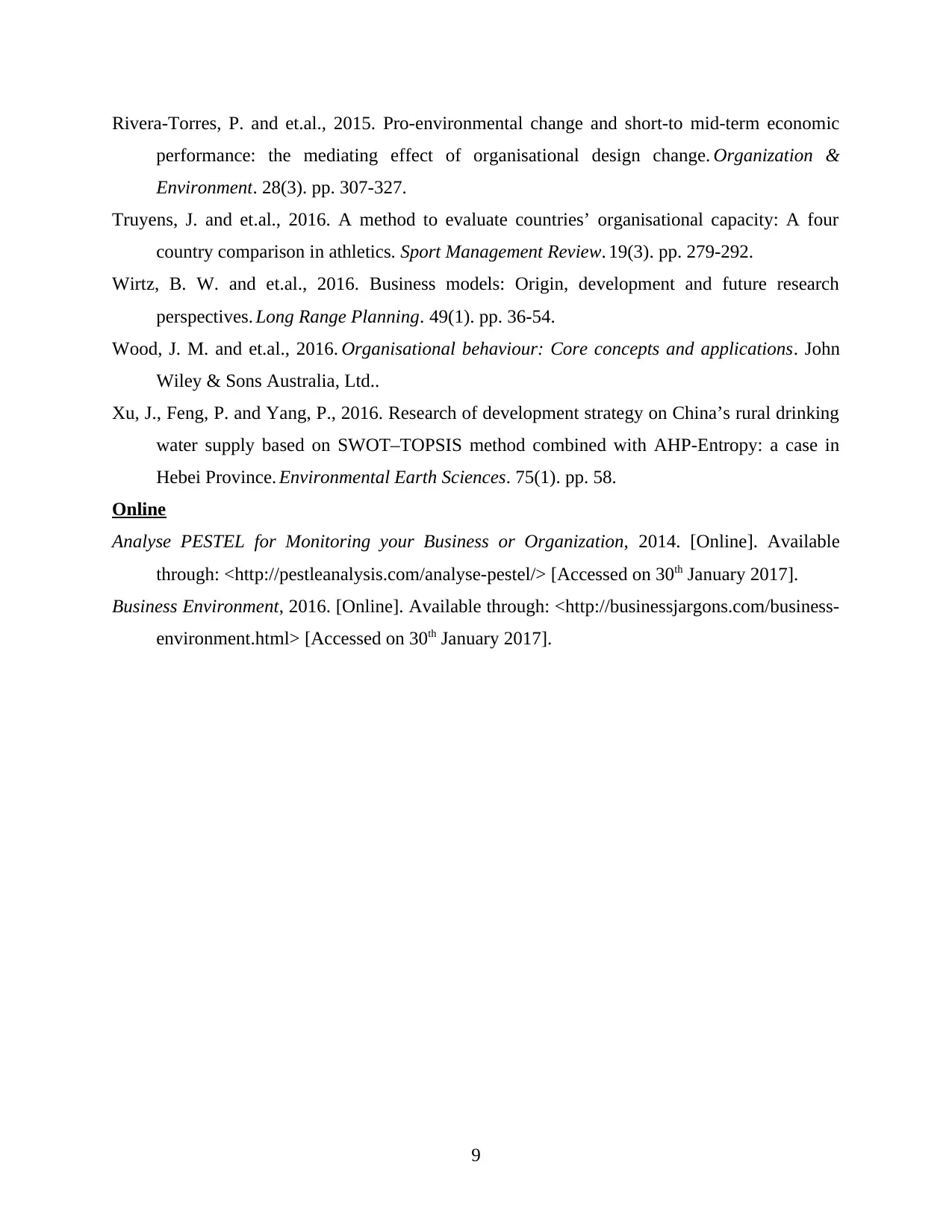
Rivera-Torres, P. and et.al., 2015. Pro-environmental change and short-to mid-term economic
performance: the mediating effect of organisational design change. Organization &
Environment. 28(3). pp. 307-327.
Truyens, J. and et.al., 2016. A method to evaluate countries’ organisational capacity: A four
country comparison in athletics. Sport Management Review. 19(3). pp. 279-292.
Wirtz, B. W. and et.al., 2016. Business models: Origin, development and future research
perspectives. Long Range Planning. 49(1). pp. 36-54.
Wood, J. M. and et.al., 2016. Organisational behaviour: Core concepts and applications. John
Wiley & Sons Australia, Ltd..
Xu, J., Feng, P. and Yang, P., 2016. Research of development strategy on China’s rural drinking
water supply based on SWOT–TOPSIS method combined with AHP-Entropy: a case in
Hebei Province. Environmental Earth Sciences. 75(1). pp. 58.
Online
Analyse PESTEL for Monitoring your Business or Organization, 2014. [Online]. Available
through: <http://pestleanalysis.com/analyse-pestel/> [Accessed on 30th January 2017].
Business Environment, 2016. [Online]. Available through: <http://businessjargons.com/business-
environment.html> [Accessed on 30th January 2017].
9
performance: the mediating effect of organisational design change. Organization &
Environment. 28(3). pp. 307-327.
Truyens, J. and et.al., 2016. A method to evaluate countries’ organisational capacity: A four
country comparison in athletics. Sport Management Review. 19(3). pp. 279-292.
Wirtz, B. W. and et.al., 2016. Business models: Origin, development and future research
perspectives. Long Range Planning. 49(1). pp. 36-54.
Wood, J. M. and et.al., 2016. Organisational behaviour: Core concepts and applications. John
Wiley & Sons Australia, Ltd..
Xu, J., Feng, P. and Yang, P., 2016. Research of development strategy on China’s rural drinking
water supply based on SWOT–TOPSIS method combined with AHP-Entropy: a case in
Hebei Province. Environmental Earth Sciences. 75(1). pp. 58.
Online
Analyse PESTEL for Monitoring your Business or Organization, 2014. [Online]. Available
through: <http://pestleanalysis.com/analyse-pestel/> [Accessed on 30th January 2017].
Business Environment, 2016. [Online]. Available through: <http://businessjargons.com/business-
environment.html> [Accessed on 30th January 2017].
9
1 out of 11
Related Documents
Your All-in-One AI-Powered Toolkit for Academic Success.
+13062052269
info@desklib.com
Available 24*7 on WhatsApp / Email
![[object Object]](/_next/static/media/star-bottom.7253800d.svg)
Unlock your academic potential
Copyright © 2020–2025 A2Z Services. All Rights Reserved. Developed and managed by ZUCOL.





